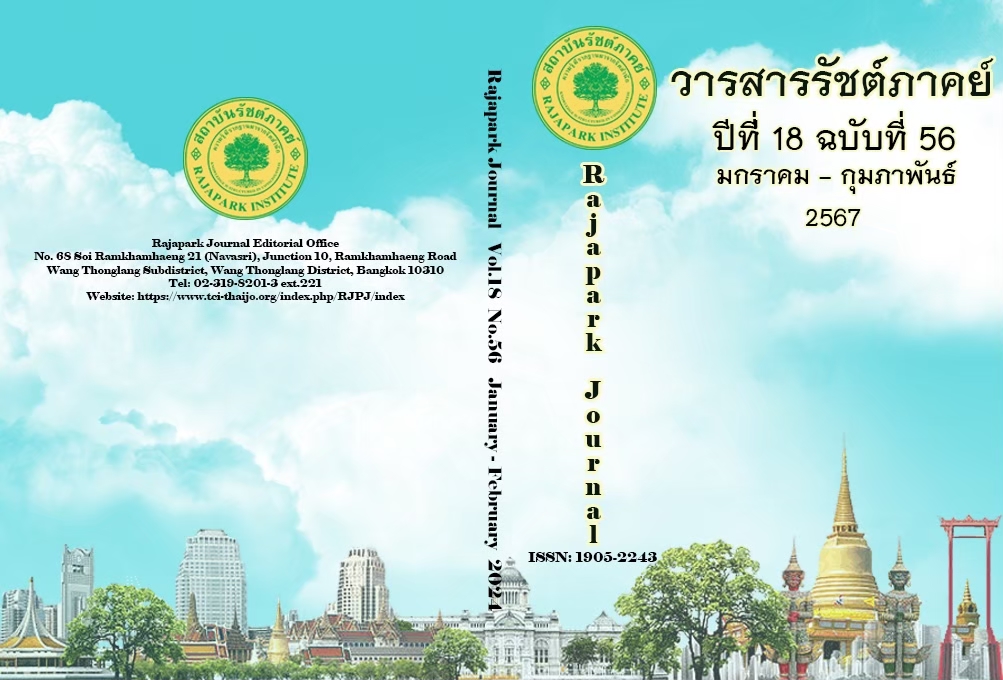Supply Chain Management of Restaurant Service Business: Case Study Ban Rong Sala Community
Main Article Content
Abstract
This research aimed to study 1) the supply chain of Ban Rong Sala Community Service Business 2) to analyze the environment and value chain activities of Ban Rong Sala Community Service Business 3) to suggest guidelines for improving the process of the Ban Rong Sala Community Service Business. This research is qualitative. Key informants include business service providers in the Ban Rong Sala community. Make selections using case study research. The tool used for data collection was a structured interview with operators and service providers for Ban Rong Sala Community Service Business. Analyze data by analyzing content from procurement, inspection, storage, production, and service processes. The results showed that the supply chain process that enters the operation process has a total of 5 steps, and analyzing the environment also found problems in service delays, inhospitable locations, and more competitors. The researcher therefore analyzes various activities in the value chain to find ways to improve and increase operational efficiency by planning production, controlling raw materials according to needs, bringing in new technologies to help reduce waiting, and training employees to have knowledge skills suitable for service by increasing skills that are important to employees, such as communication, language, and use of technology or various tools necessary to provide services, to create a competitive advantage.
Article Details

This work is licensed under a Creative Commons Attribution-NonCommercial-NoDerivatives 4.0 International License.
Views and opinions appearing in the Journal it is the responsibility of the author of the article, and does not constitute the view and responsibility of the editorial team.
References
Aphiphattharawarodom, K. (2020). Service Marketing Mix Used to Analyze Business Opportunities to Support Chinese Tourists: A case study of Satorn and Srilom Area. Journal of Humanities and Social Sciences Thonburi University, 14(3), 160-170. https://so03.tci-thaijo.org/index.php/trujournal/article/view/225382
Chaiyasain, C. (2018). Guideline for Competitive Advantage and Service Innovation for Restaurant Business 4.0 to Encourage and Develop Phuket a Gastronomy Creative City. Dusit Thani College Journal, 13(3), 491-504. https://so01.tci-thaijo.org/index.php/journaldtc/article/view/241133
Eksirichaikul, N. (2013). The Value Chain Management Model of Catering Business for Nakhon Pathom Province Related to Creative Economy Concept[Doctor of Philosophy Program in Developmant Education, Silpakorn University].
Haschu, M. (2020). A Study on Analyzing The Supply Chain And Value Chain For Developing The Community Enterprises And One Tambon One Product[Master of Science Program in Department of Food Technology, Silpakorn University].
Heonsawang, P., & Jewjinda, C. (2020). Success Factors of Operating a Thai Restaurant Business in the United States. Journal of Administrative and Management Innovation, 8(3), 106-115. https://so02.tci-thaijo.org/index.php/RCIM/article/view/243569
Kaijan, P., & Patanathabutr, R. (2022). The Managerial Guidelines for Food and Drink Businesses in Industrial Area of Suengnoen Sub-District, Suengnoen District, Nakhonratchasima Province. NEU Academic and Research Journal, 12(1), 73-84. https://so04.tci-thaijo.org/index.php/neuarj/article/view/252581
Kasikorn Research Center. (2022) The Impact of The Corona Virus Epidemic 2019 on Restaurant Business 2020. https://www.kasikornresearch.com/InfoGraphic/Documents/3090_p.pdf
Laoketkarn, C., & Wangkananon, W. (2018). Causal Model of Supply Chain Integration on Hospital Service Quality. Under The Office of
Permanent Secretary, Ministry of Public Health. Journal of Thonburi University, 12(28), 124-137.
Ministry of Public Health. (2022) Act Public Health B.E. 2535 (1992). http://odpc9.ddc.moph.go.th/DPC5/(1)law-health35.pdf
National Statistical Office. (2022) The 2022 Business and Industrial Census Basic Information: Northern Region. www.nso.go.th/sites/2014/Pages/สำมะโนธุรกิจอุตสาหกรรม/2565/doc/North/Complie%20NORTHERN%20REGION.pdf
Ochka, S. (2021). Supply Chain Innovation Management of Healthy Food Products in Bangkok. Journal of Social Science and Buddhistic Anthropology, 6(11), 421-434. https://so04.tci-thaijo.org/index.php/JSBA/article/view/251795
Plengplang, P. (2019). Supply Chain Management in Social Enterprises: Case Studies of Social Enterprises in Chiang Mai Province [Master’s thesis, Chiang Mai University].
Porter, M.E. (1985). Technology and Competitive Advantage. Journal of Business Strategy, 5(3), 60-78.
Sae-lee, P., & Pochan, J. (2021). Supply Chain Management in Melon Production: A case study of Melon Hydro Green Farm. Industrial Technology and Engineering Pibulsongkram Rajabhat University Journal, 3(2), 182-197. https://ph02.tci-thaijo.org/index.php/psru-jite/article/view/244801
Sereerat, S., & Laksitanonsuporn, P. (1998). Marketing Strategy and Marketing Management. Bangkok: Theera Film & Scitex.
Sivaborvornvatana, N. (2022). A Study on the Supply Chain that Creates Value Added for the Cassava Industry in Thailand. Journal of Pacific Institute of Management Science Humanities and Social Science, 8(1) 461-462. https://so05.tci-thaijo.org/index.php/pacific/article/view/257160
Srihirun, J., & Pangkaew, O. (2020). Cloud Kitchens: Opportunities and Challenges Toward Competitive Capacity of the Restaurant Business. Southeast Bangkok Journal, 6(2), 99-115.
Zhao, L., Zhao, X., Sun, L., & Huo, B. (2013). The impact of supply chain risk on supply chain integration and company performance: A global investigation. Supply Chain Management, 18(2), 115-131. https://doi.org/10.1108/13598541311318773


